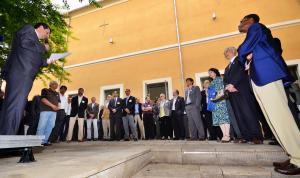At age 25, Tore Supra is still far from being a museum piece. It is in a museum however that the anniversary of the CEA-Euratom tokamak was celebrated last Tuesday evening in Aix-en-Provence.
Why a museum? Why not ... the old priory of the Knights of Malta, now the
Musée Granet, was the perfect venue for the informal commemoration, providing a large shaded courtyard for the speeches, beautiful rooms to wander through and exceptional works of art to admire...
As he briefly retraced the history of fusion research and the part played by Tore Supra, Richard Kamendje of the International Atomic Energy Agency, drew this parallel between fusion science and art: "Every generation," he said, "faces similar challenges. But because you are living in a certain moment in history, you answer these challenges with the tools that belong to your time."
One of the very first fusion machines to implement superconducting coils, Tore Supra certainly rose to meet several challenges over its 25 years of operation. Originally led by the installation's designer Robert Aymar, Tore Supra teams explored the domain of long plasma discharges, achieving a record six-and-a-half minute "shot" in 2003 that produced one Gigajoule of energy.
Tore Supra pioneered the technology of actively-cooled plasma-facing components, real-time diagnostics, in-vacuum robotics... A quarter century after First Plasma was achieved on 1 April 1988, this accumulated expertise forms one of ITER's major assets.
An anniversary is an occasion to reflect on the past, often with emotion, and to welcome the future, often with enthusiasm. Both Alain Bécoulet, the present Head of CEA's Research Institute on Magnetic Fusion ( IRFM, the laboratory that operates Tore Supra), and his predecessor Michel Chatelier (2004-2008) expressed their conviction that the machine's future will be no less brilliant and exciting than was its past.



